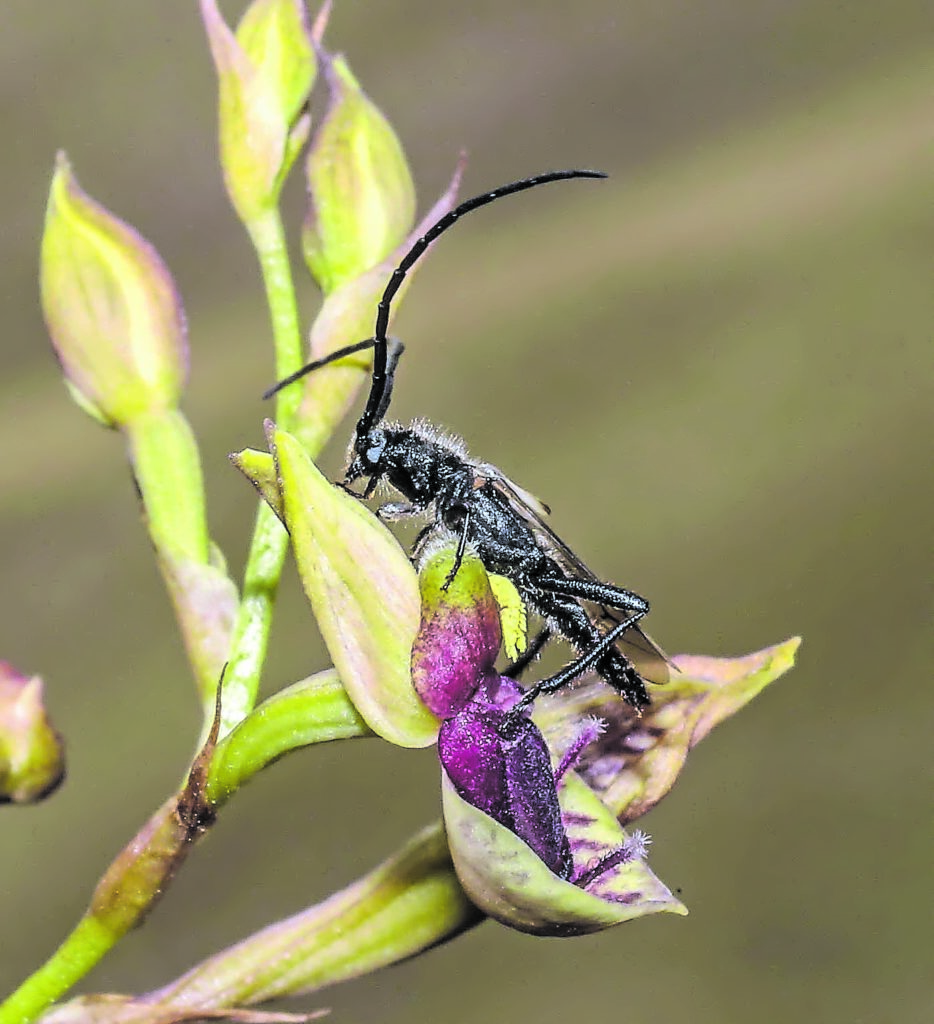Sexual deception: A male longhorn beetle ‘mating’ with a rare Disa forficaria orchid in the Western Cape in 2016. Photo: Callan Cohen/birdingafrica.com
It was while Dr Callan Cohen was documenting the near-extinct Disa forficaria, a critically rare orchid, in the mountains east of Cape Town in 2016, that he witnessed another incredible spectacle: a male longhorn beetle flew to the plant and mated with it.
Cohen, a research associate at the University of Cape Town’s FitzPatrick Institute of African Ornithology had discovered a world-pollination first: the Disa forficaria, which is known from a single remaining plant in the mountains, mimics the appearance and chemistry of a female longhorn beetle so convincingly that the unwitting male beetle mates with the flower, pollinating it.
“I study orchids and pollination and so when I saw the beetle mating with the flower, I knew what was happening and that it had never been seen before,” Cohen said.
Over the past 200 years, only 11 of the plants have been spotted, making it one of the world’s rarest botanical treasures. The last sighting in the Western Cape was in 1966, but in March 2016, a lone Disa forficaria was rediscovered in a local nature reserve.
 © Callan Cohen www.birdingafrica.com FitzPatrick Institute of African Ornithology, University of Cape Town
© Callan Cohen www.birdingafrica.com FitzPatrick Institute of African Ornithology, University of Cape Town
This was where Cohen was photographing the plant, when he saw the beetle land on its flower. The beetle, he said, had a small, penis-like organ, which it inserted into the modified lip of the flower. The sperm found on the flower marks it as only the second time in the world that an insect has been found to ejaculate on a plant during pollination.
Cohen put together a team of local and international experts, including pollination and orchid experts, to investigate the phenomenon. They have discovered that a novel chemical system is involved in the orchid’s sexual deception — a previously undiscovered macrolide, which they have named disalactone.
Their findings are detailed in the paper, Sexual Deception of Beetle Pollinator through Floral Mimicry, which has now been published in the journal Current Biology.
The study describes how the male longhorn beetles “pollinate the elaborate insectiform flowers” of the Disa forficaria, while “exhibiting copulatory behaviour, including biting the antennae-like petals, curving the abdomen into the hairy lip cleft and ejaculating sperm.
“The beetles are strongly attracted by a novel macrolide that we isolated from the floral scent,” according to their paper.
Orchids are masters of deception, imitating plants with nectar despite having none, and using sexual trickery on bees and wasps. This, however, was the first clear case of an orchid sexually deceiving a beetle.
The team is now pioneering the process of using pollination to survey the presence of critically endangered plants. “We now have the chemical that the plant uses to lure the beetle and we can make it in a lab,” Cohen said. “We then go to an area we want to survey, and attract all the beetles using the chemical lure, and check to see if they have any of the plant’s pollen on them.
“If they do, the plant must be nearby, and we can do a detailed search for it. So far, we have found that two more plants must exist, although we could not actually find them,” Cohen said.
The site where the plant was found cannot be named, because Disa forficaria is under threat from orchid collectors. Cohen said the particular orchid he studied in 2016 has since disappeared, “either stolen by a collector or dug up by a mammal”.
The beetle, he said, is critical to the plant. “If the beetle went extinct, so would the plant. However, the plant is not critical to the beetle. The beetle is looking for female beetles and gets distracted and fooled by the plant, but then it moves on with its search.”